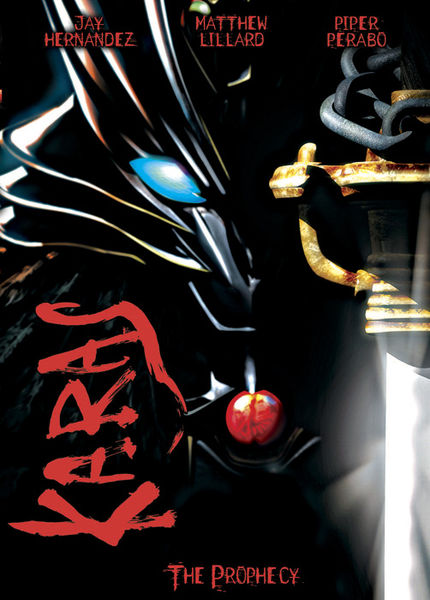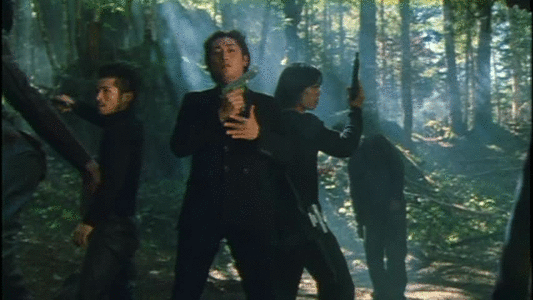
I have decided to redo my first review that i posted up here, as it bothers me that i’ve let Ten Years Too Late sit stagnant for so long (this is really because of a tremendous amount of homework i’ve had lately). So i’m going to keep the lights on here by tidying up this review’s format and diction.
Also i consider warning people about this awful awful movie a bit of a social responsibility so you’re welcome!
I first saw this film at the young age of 18. I was just out of school and working a part time job, of which i was spending all of my earnings cruising through the HMV’s that were scattered throughout Edmonton and amassing the lion’s share of my DVD collection.
Having seen or purchased some of the best anime had to offer (Akira, Perfect Blue, etc), i decided to explore some of the other more obscure offerings of the genre. Having seen the box art of Karas: The Prophecy a number of other times before, i decided to read some reviews of it and found it to be awash in superb ratings and recommendations. So i took the plunge and spent 25 whole dollars on it.
And after the movie abruptly ended stopped, and left me in complete and utter bewilderment, I made a promise to myself:
never ever believe what the anime community recommends for good anime…
THE GOOD
Surprisingly, the movie does have some redeeming features. For one it is an extremely well animated movie. The intro sequence alone is worth a look, featuring a fantastic aerial duel between two armoured beings that shape shift between dog fighting jets, and sword wielding samurai thingys. The action takes them from the high skies above Tokyo (presumably) to the building tops in spectacular fashion, and its a great example of a “shark attack beginning” that serves to really grab your attention and make you wonder what is in store next. The other duels, don’t quite match the scope of the introductory one, but they do not drop in quality of presentation and execution throughout the movie.
The animation is complemented with a nice slick visual design of the characters and settings. The basements are suitably grimy, and the more mystical areas are majestically presented. the characters themselves have at least memorable looks that serve to distinguish them from each other, which really really helps because if it weren’t for that i feel any viewer would be absolutely lost in trying to follow along with the various plots that come up.
The last positive thing i can say about this film is that the animation and visual design are accompanied by a wonderfully passionate score from Yoshihiro Ike. Notably it pops up whenever Karas shows up, with dashes of a full choir and a strong brass and treble section it lends a nice heroic theme in the same vein as Danny Elfman’s Batman theme or even John Williams Superman theme.
THE BAD
The worst offence of this film will have to lie in its story, to say that Karas’ plot is “amateurish” is to put it lightly, very lightly. For starters it has five distinct plots all vying for attention in a film that boasts a running time of barely 80 minutes. They are as far as i can discern as follows:
1. The introduction of a new Karas (presumably a guardian of humanity) following the defeat of the previous one in the introductory battle sequence, he is given these powers by what i will name Goggle Girl #1 for lack of any memorable name.
2. The villain’s own agenda of creating machine demons to terrorize the citizens of Tokyo, he also keeps (presumably) a Goggle Girl of his own in a tank for some reason.
3. The story of two cops assigned to investigate the killings perpetuated by the demons.
4. The redemption quest of one of the spirit beings, to hunt down and kill the demons wherever they may be hiding.
5. The agenda of Goggle Girl #2 and of (presumably) her own Karas to prevent something from happening to everyone i guess.
Yes. All of that is crammed into 80 whole minutes of absolute confusion. The cop story gets the lions share of the running time, and due to it being tied by circumstance the redemption spirit story gets most of the rest of it. Now this wouldn’t be a bad thing per-se if the movie just picked one of these threads to follow, but that just plain old doesn’t happen.
All of these stories running in tandem in a film of such length brings up another terrible flaw; the fact that new characters are introduced in just about every other scene for most of the running time. This has the result of important unresolved plot points being skipped and vital exposition being sidelined for more plot to be piled on and more questions to be asked.
Adding to the confusion, most of the scenes feel like they start in the middle of something, like the conversation between the characters had just about wrapped up and we only see the result of it (most of the scenes involving Karas and Goggle Girl #1 are like this). The movie is structured in such a way that you feel like you should have a book of it opened in your lap and pause the movie after every scene to read up on the moments that come between each. Half of the movie goes by before you’re even remotely given anything resembling an explanation as to who anyone is and what is happening.
I simply cannot stress hard enough about the fact that the film’s narrative structure is awful. With the running time being so short you would figure that the producers wouldn’t put one inch of fat into the narrative. I can tell you if you make that assumption you would be miserably disappointed, there is plenty of fat to trim in the movie, i will sum up the biggest example:
– The scene starts by introducing two new characters to the film, a young couple driving in a tuned up car through a tunnel. They are as a side note given more than a few lines to say to each other.
– The man spots another similar looking car ahead and gets it into his head that a street race would be a good thing to do.
– The car he is racing turns out to be one of those machine demons that have been set loose, after dissolving the man’s old lady via a purple mist it sets its attentions on the car and begins to tear it up via its large saw blades it has for arms.
– Redemption Spirit man shows up and duels with the demon machine. The duel is evenly matched.
– Karas also shows up via long already seen and established introduction and duels with the demon.
– The demon escapes to fight another day.
So that’s the scene in a nutshell, there are a few details i may have missed or confused but that is irrelevant to the problem this scene presents when taken into the structure of the movie as a whole. This being chiefly that it doesn’t need to be present in it at all.
Everything in it has either been shown previously, or could be shown later to no ill effect. Redemption man is shown hunting the demons down in the previous scene, and just like before he doesn’t get the chance to ice them as Karas shows up. Karas’ powers and purpose are introduced in the previous scene as well, that being to hunt and destroy the demons. Why is all that reiterated here?
We don’t learn anything more about the plot or the characters, as this scene is mostly used for set up of the road demon for a later action sequence, however you could take this scene out completely to no ill effect of that later one; as the film has already set up the fact that the demons are hiding and hunting around the city in mundane forms. The later tunnel sequence revisits and one ups this scene by having Karas kill the demon, and having an important detailed revealed about redemption man, as well as some other plot details being introduced (these are of course represented as new characters). Making this one irrelevant when viewing the movie as a whole.
Taking all of that into account its easy to see that the whole sequence is pure filler. Yes that’s right; in a movie this short, bursting at the seams with dangling plot threads, and overloaded with characters the producers thought it necessary to include an unneeded action scene.
THE UGLY
This film has been produced by people who have no concept of what makes a story a story. They seemed to have decided to skip out on the boring little things like: exposition, narrative structure, and scene cohesion. Instead they overloaded it with cool things like: Katana’s, duel wielding .45’s, gruesome deaths, jets, burnt out cops, and fast cars.
Now maybe you would think that makes this film not worth watching (or really worth a look…), but i truly believe that Karas: The Prophecy should be shown by any film studies instructor as a one of a kind example of how bad a plot can be presented. It’s like the plot was a beautiful stain glass painting and someone threw a hammer into it, and then glued in the prettiest colours back into the frame.
It is also shows how flawed my young mind was, while watching Star Wars and all the while thinking:
“Why aren’t there more light saber duels/shoot outs?”
Not realising that all action scenes in order not to be completely incomprehensible and utterly boring in their motivations must evolve from the plot naturally, and not just be plunked down anywhere you may feel like it.
So i guess, a thank you is necessary Karas: The Prophecy thank you for showing us all how not to suck.
* STAR OUT OF FIVE






